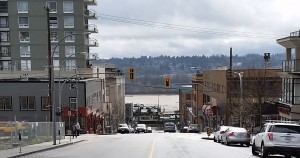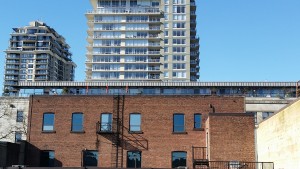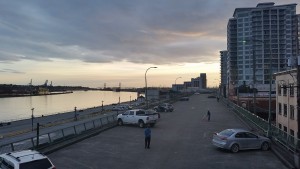There has been quite the recent resurgence in interest in the Front Street Parkade, led by a three-man crusade to derail the City’s new waterfront vision. I applaud their passion and the work they have done to create a media buzz around a topic that had been settled in most people’s minds years ago, but I am unconvinced by their arguments, and don’t think the City is going to change direction on this project.
Before I am accused of being dismissive of a grassroots campaign being led by three very enthusiastic citizens, I want to suggest the opposite is true. I have heard two sets of delegations in Council, had several conversations at a community OCP Open House, and have taken a 2+ hour walk-around of the Parkade guided by the gentlemen leading the charge. I also attended the Rally on the Parkade last weekend, have been involved in lengthy Facebook conversations in regards to the proposals, attended RA meetings where the proponents have spoken a length about their plans, have received (and responded to) dozens of e-mails on the topic, and have been interviewed by radio, tv and print media answering the same questions in as many ways as I could. I dug back into the City records from before my time in Council so I can better understand the convoluted path to where we are now. I have done everything I can to inform myself about this issue and see the vision these gentlemen are offering. I have asked and answered many questions. After more than a month of discussions, I remain unconvinced by their arguments, not dismissive of them. And I am afraid this is going to turn into an extended rant, so pour yourself another coffee before you proceed…
The idea of partial (or at that time, complete) removal of the Parkade came about years ago, when earlier models for the New Westminster Waterfront that included upward towards nine towers on a large pedestal began to be questioned. With the results of the road diet on Columbia Street, the resurgence of the River Market and desire for better connectivity to the waterfront, the development of the Westminster Pier Park and cancelling of the North Fraser Perimeter Road waterfront-freeway concept, the City began to redraw the waterfront, turning a 1970’s freeway-and-closed-community model into a modern open-space-mixed-use one. This coincided with the years-long development of the regional growth strategy (finally adopted in 2011) and its companion Regional Transportation Plan, which changed how the entire region looked at transit-oriented city centres, mixed-use development and the introduction of freeway growth to our region.
As part of re-examining the waterfront, the City of New Westminster looked at the largest structure in the waterfront and tried to determine what to do with it – the fate of the Parkade was going to decide on the fate of the waterfront over the next 20 or 30 years, merely by its existence – so the first step was to put a business plan to its continued existence or removal. This involved two things: an engineering assessment of the life-cycle cost and revenue opportunities of the Parkade given various repair/removal scenarios; and a Downtown Parking Study that informed a long-term parking strategy (adopted by Council in 2013) to assure that parking needs in the downtown could be met to the satisfaction of Downtown businesses and other stakeholders even during the current growth cycle. This is a rational, good-governance approach to long-term planning, one I cannot take any credit for as I was not on Council at the time.
From an engineering and costing perspective (including revenue opportunity and eventual deconstruction costs – so a true “life cycle cost analysis”), the best solution was to repair half of the Parkade so it could provide revenue over the long term, but to deconstruct the other half to reduce the cost of maintenance and upgrades. It makes sense: fix the part that makes you money, get rid of the part that doesn’t. Now that is only the dollars-and-cents side of the argument, and if we were a business called Waterfront Parkade Inc., we might have ended it there and gone ahead with the demolition the business case suggested 5 years ago.
However, we are a City, so we need to think bigger. We need to engage stakeholders, talk to the people who use the Parkade, those who would benefit or be inconvenienced by its removal and those whose tax dollars we would be investing (or not) in the long-term viability of the Parkade. Fortunately, the Downtown Parking Study also supported the removal of half of the Parkade, given a number of conditions, which were rolled into the strategy. There was also much discussion about what the removal of half of the Parkade would mean to the waterfront, to Front Street, and the future developments in the area. The consultations and opportunities for public and stakeholder engagement were plenty- I remember attending many of them. There have been numerous open houses, stakeholder meetings, and Council Reports since the serious discussion around Parkade removal started around 2011. I have been blogging on this topic since (checks his archives) December 2011 on this very topic, including attending an earlier “Save the Parkade” movement that seemed to have lost steam as many of the valid issues they raised were addressed through the consultations. A quick perusal of the Googleable record of this project shows the City has engaged, adjusted plans, worked with the BIA, adapted and developed a comprehensive vision over several years.
Almost a year ago, RFPs were prepared and a consultant was hired to develop a process to get the works done. As there are three separate but integrated projects going on at the same time, it was important that they be coordinated to assure that parking is always available and the interruptions to adjacent businesses are mitigated. That work is on-going, and tenders are out for the first part of the larger project.
I should also note that I am not unbiased here – I have been on record going back to at least 2011 that I agree with the City’s ongoing waterfront vision as it has developed, and think the Parkade is something that is hindering the development of our downtown and waterfront, not helping it.
For the record, the current plan (yes, it is subject to change, as engineering and construction plans usually are) is to first do most of the necessary repairs to the east half of the Parkade. During that the east side will be mostly closed to traffic, but the west side will be able to accommodate the current parking needs. Following the repairs, the demolition of the west half will proceed. This will take up to 12 weeks, and traffic closures on Front Street are expected during that time (a traffic management plan is being developed as we speak). Once the demolition is completed, work on the Front Street Mews, from utility relocations to sidewalk, planter and pavement repairs will be completed. Hopefully, everything will be completed by spring 2016, with the exception of the application of a sealant to the surfaces of the east Parkade, which will occur in a sunny week over the summer (requiring likely closure of portions of the Parkade at a time)
That is the plan. Council has approved the plan, and sent the job out to tender. Tenders closed this week, and we anticipate moving forward with that plan. You may say “plans can change”, and I agree – Council should be amenable to changes in tack if a good case is made for doing so. However, as compelling and passionate as the current campaign messaging is, I do not hear a case compelling enough to turn over 5 years of planning and consultation.
As such, I would like to go through the relevant points of the “Rescue our Parkade” campaign and address their specific concerns.
“The City should not waste $11 Million on a demolition project”.
I have tried many times to correct this fact, yet like a zombie it keeps on coming back. The demolition of the Parkade will not cost $11 Million. That is the estimated (and I emphasize “estimated”, as contracts have not yet been awarded for the work) cost of the entire waterfront project. The demolition of the west half of the Parkade will cost approximately $3.85 Million. The repairs and refurbishment of the east half of the Parkade, to get another 20 or 30 years out of it, will cost about $5.2 Million. Restoration of the streets, building of sidewalks and utility works related to the Front Street Mews will cost about $2 Million, and the installation of an art project to soften the outside of the remaining Parkade will cost about $200,000. The cost of upgrading and repairing the west half would be much higher than the demolition costs, so at that basic level, demolition saves us money when factoring in true life-cycle costs.
“There is no rush to do this”
As I hoped to outline above, this is anything but a rushed process. This is the end of a 5-year vision development: through three City Councils and two Mayors, through studies and consultations and capital budget preparation and planning. In February, this council unanimously endorsed the plan and approved the moving ahead. This project is not rushed, it is overdue.
“There is no need to repair the Parkade”
The City has had several professional evaluations of the condition of the Parkade over the years, and the consensus is that extensive maintenance work is required very soon if we are to keep it for the longer term (more than 10 years). Concrete is currently spalling and creating a hazard to vehicles below, there is evidence of water intrusion through the concrete and rusting of the steel reinforcement. There is evidence that enough chloride has leached into the concrete to the depth of the steel that the corrosion-inhibiting properties of the concrete are inhibited. The railings, lights, stairs, wheelguards, and other “jewellery” are past their service life and fall far short of modern safety codes. If we don’t do these things now, we will need to do them soon, and there is no reason to believe things will get less expensive as we wait. “Just doing nothing” right now is not an option I would support at Council.
“Things on Front Street will not improve”
As was noted during a delegation to Council – there is a reason they held the rally on top of the Parkade and not under it. The same reason CBC would not interview me under it, but beside it. The same reason the underside of the Parkade has represented various dystopian or post-apocalyptic futurescapes in films. It is dark and unpleasant under that thing, and light and fresh air can help.
But this is not just about Front Street, it is about the entire waterfront. The views of the water from all of the intersections on Columbia will be better, there will be a safer level crossing at 6th, the enhanced level crossing at Begbie, and all the pick-a-views in between. Not to mention the view back from the waterfront – the new parks existing and planned – will look back at a row of heritage buildings, now with enough retail appeal and viability that their windows can be unboarded and their facades improved.
“Why tear it down when it earns revenue?”
The Parkade indeed earns revenue for the City, something like $400K per year, and will continue to do so once the work is completed. The number of parking spaces being preserved (450 or so) far exceeds the number normally occupied, and even exceeds the number occupied during the busiest events downtown.
“Save it for the benefit of the Trapp+Holbrook folks or the Larco folks”
The developers of the Trapp+Holbrook building are not only in favour of this decision, they advertise it on their website to make sure that people thinking of buying at their building know what is going on, and make the eventual removal and re-imagining of the Front Street Mews part of their marketing. To quote their marketing materials; “There is no doubt that the reconstruction of Front Street is a step in the right direction for downtown New Westminster.” Similarly, the developers of Larco went through a recent Rezoning of their property fully acknowledging the waterfront vision endorsed by the City. Indications are that they see the enhanced Front Street Mews as an asset for their development.
“An elevated park would be an asset”
Yes! I can see that vision. An elevated park could very well be a welcome asset on New Westminster’s waterfront. The idea of a High Line-type elevated park above the Pier Park is intriguing. However, very little of the “Rescue our Parkade” vision depends upon preserving the west half of the Parkade; the remaining east half might actually be a better location for this type of use. Of course, we don’t have any money to do that right now, and if people ask me if an elevated park adjacent to Pier Park is a higher priority than connecting the Pier Park upriver to Sapperton Landing, building a Q2Q crossing, or even planned improvements to the Canada Games Pool or the Gas Works Site… then I will say no.
When I raise the issue of the cost of building a facility like the High Line, the proponents reply “We are not asking the city to create a park, just to save the parkade”, which might have been the moment when I decided this lengthy rant was necessary. Because a High Line-style park is exactly what they are selling. They show photos of it on their website and in their presentations, they emphasise the park in their presentations, they invite landscape architects from UBC to opine on the possibilities. They may not be asking for a park, but that is definitely what they are selling to the people they are engaging with, and (by language or inference) they are suggesting that we can have that for less than the price of the demolition of the west half of the Parkade, which is patently false.
“Why is council not listening?”
We are listening, and we are hearing. After several years of discussing the Parkade, we have heard many different opinions on it. I have been spending the last two weeks asking people I run into all around town what they think of “Saving the Parkade”. A few people have come to Council, and they have been given a forum to express their views. We have received correspondence from people who support their ideas, and we have received correspondence from people who cannot believe we are having this discussion now. I can quote a few of the letters I have received:
“[demolition] cannot happen fast enough”… “I think it is clear how much Front Street will be improved once the western half of the Parkade is gone”… “I am so thankful you are tearing down the Parkade”… “please stick to the plan of tearing it down”… “I took part in the 2012 and 2013 open houses, I then and now support the decision”… “stick with your guns and let’s get on with the business of connecting Downtown with the Waterfront”… “I urge you to follow through so we can be rid of this 1960’s era relic”…
But ultimately, my job is not to tally up the yeas and nays on a spreadsheet – plebiscites are a terrible way to conduct leadership. My job is to make better decisions for the people who elected me, based on a serious analysis of the data available, and to set priorities with the money that citizens and businesses entrust in the Council. This decision was based on a long-term vision, developed through extensive public and stakeholder consultation, that was found to meet a number of long term goals for the community, and made the most economic sense. That is what we, as a Council, were elected to do for the community. During the election I talked to thousands of people, and exactly one person asked me to keep the Parkade if elected – and he was running for council against me at the time!
Would an elevated park be better than a parking lot? Perhaps. Is this something the City could explore for the east half of the Parkade after it is repaired? Sure. I have been to the High Line, and loved it, but it is a unique experience in a unique part of Manhattan. For New Westminster, we would need to look at the viability, figure the costs, and have a discussion with the community about whether that is a priority right now, and what other projects we might drop to make it a priority. I am not afraid to have that discussion, and I hope these three gentlemen will bring their obvious passion and energy to that discussion if the community really wants to consider this for the remaining east half of the Parkade.
But none of these ideas are currently costed, none of them have been evaluated by an engineer who will put her stamp beside her assessment, none of them have seen regulatory review, none of them have been through any form of public consultation, and none of them are currently in the capital budget for the next 5 years. We can make these things happen (pending technical and engineering concerns, of course), if people want them to. I just hope that if we spend a few years developing a vision like this, find the budget money, and do several years of public consultation and revision based on public input, a grassroots group doesn’t crop up at the end of it all to oppose it by saying “Where the hell did this idea come from? What’s the rush? White Elephant!”
But it probably will.





